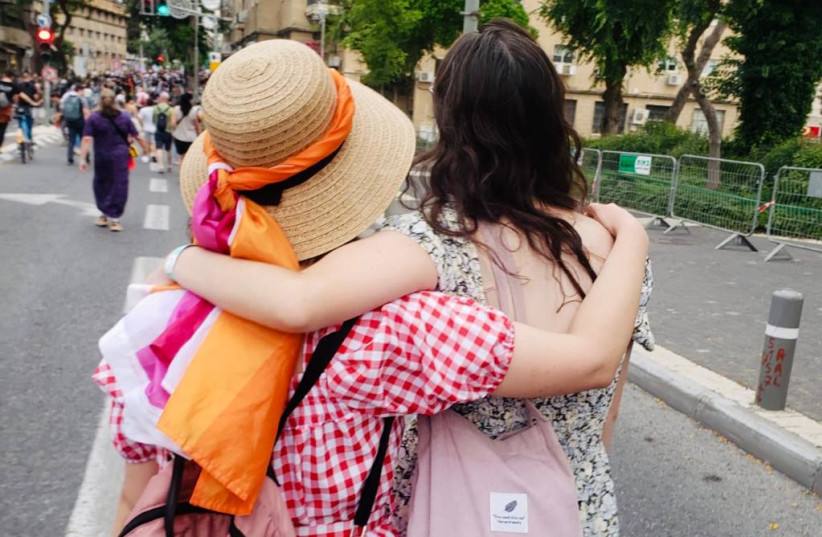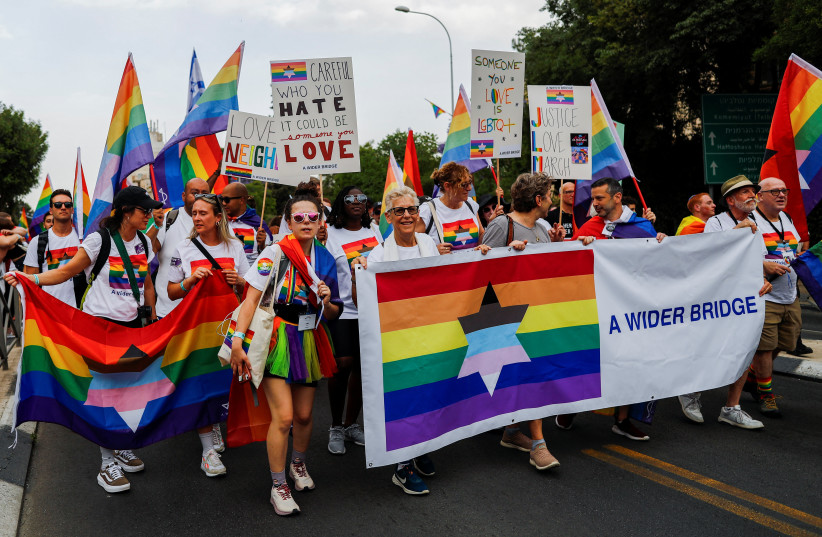The Jerusalem pride march is a holy event – comment
Jerusalem is a holy city. Inside the walls of the Old City are endless reminders of this fact, with the Western Wall, the Church of the Holy Sepulchre and the Dome of the Rock serving as some of the most important sites to members of the three Abrahamic Religions.
Jerusalem is a modern city. It has a population of 984,500 people, and that number is only increasing. Some 590,600 Jewish residents live alongside 362,000 Muslims and 15,900 Christians – all of us sharing the same spaces, riding the same bus lines, and walking the same streets.
Jerusalem is a modern city steeped in religion, where school students cram onto the bus in the morning muttering their morning prayers, where construction workers pause several times a day and unroll their prayer mats, where you’ll see nuns and bishops walking along the crowded main streets.
And every year, on one day in June, the streets of the city become adorned with rainbow flags and thousands flood the streets, chanting and singing as they celebrate the city’s diverse LGBT community.
As that day rolls around each year, a predictable cacophony of complaints comes with it.
 People take part in an annual LGBT Pride parade in Jerusalem, June 1, 2023 (credit: Maya Zanger-Nadis)
People take part in an annual LGBT Pride parade in Jerusalem, June 1, 2023 (credit: Maya Zanger-Nadis)“They can do what they want in the privacy of their own homes but why do they need a parade?”
“Jerusalem is the holiest city in the world, the pride march is nothing but incitement and intolerance.”
And that’s to say nothing of the large protests that take place from across the rows of barricades each year, with the barricades growing substantially after 16-year-old Shira Banki was murdered during the Jerusalem pride march in 2015 by Yishai Schlissel, an ultra-Orthodox extremist who is now serving life in prison.
All these commenters, all the protesters, there’s one thing they all get wrong. They assume that the Jerusalem Pride and Tolerance march is unholy. But they couldn’t be further from the truth.
Jerusalem is a holy city and the people who live in it are holy, including those who fall outside of the expected norms of a religious city.
The boys marching with rainbow kippot and the girls dancing hand in hand – they are holy. The families with young children who are showing them what it means to be inclusive, accepting and loving – they are holy.
 Israelis march in Jerusalem during the pride march on June 1, 2023 (credit: REUTERS/Ronen Zvulun)
Israelis march in Jerusalem during the pride march on June 1, 2023 (credit: REUTERS/Ronen Zvulun)Before the march sets out each year, weaving its way from Liberty Bell Park to Independence Park, a rabbi or scholar will lead the crowd in Tefilat Haderech – the Jewish prayer said before a dangerous journey.
Because marching for LGBT rights in Jerusalem is not safe. It is a dangerous decision, one that attendees don’t take lightly, and if they do, the Shira Banki memorial along the way will remind them of the risk.
This year, as crowds gathered for the Tefilat Haderech prayer, a rabbi in a white shirt, a black hat, and a dark beard approached the microphone to lead the prayer with an accent that those who grew up Orthodox will immediately recognize as a distinctly anglo-Orthodox accent.
Rabbi Mike Moskowitz: You can be queer and observant
Rabbi Mike Moskowitz, the Scholar-in-Residence for Trans and Queer Jewish Studies at Congregation Beit Simchat Torah, the world’s largest LGBT synagogue, told the Jerusalem Post that he had flown in from the US specifically to attend the March.
“People have said that you have to choose between a religious identity and a queer identity,” he says. “There are people who happen to be queer and there are people who happen to be observant, and only one of those is a choice.”
Moskowitz, who has three ultra-Orthodox ordinations from prestigious centers of Jewish learning, tells the Post that for him, it is important to be able to serve as an Orthodox voice for the LGBT community because it’s what Judaism dictates.
“There are people who happen to be queer and there are people who happen to be observant, and only one of those is a choice.”
Rabbi Mike Moskowitz
“It’s important for all sorts of reasons, but the most important, to me personally, is to reclaim our tradition that isn’t one of exclusion.”
To be LGBT in Jerusalem is to be excluded. It is to watch as the deputy mayor of your city disparages your existence, and says that “Jerusalem residents are not interested in the matter [of LGBT rights]; Jerusalem is one of the four holy cities. We have psychologists and psychiatrists; there is no need for special treatment.”
To be LGBT in Jerusalem is not to request or expect special treatment. It is to hope that someday you are counted among your nation, and are equal in the eyes of the law.
It is to hold hands with your partner in fear, to worry about your neighbors finding out, to carry a silent ache with you always, knowing that you cannot raise a family in the city you chose to call your home.
It is to burn with silent anger as you are ignored over, and over, and are told that you live in sin, even as the shelves of your home are lined with Sefarim and as you watch the glow of the Shabbat candles sink into the wax every Friday night.
Kadosh, kadosh, kadosh.
Holy, holy, holy.
These are the words said at the start of the Kedusha prayer, every day of the week, every Shabbat, and every holiday.
They are the words that echo in my mind as I hear the Rabbi recite the words of the Tefilat Haderech, and the words I hear in the sound of the footsteps of those marching for their right to be equal.
Kadosh, Kadosh, Kadosh, Adonai Tz’vaot M’lo Khol Ha’aretz K’vodo.
Holy, holy, holy. The Lord of Hosts, The entire world is filled with His Glory.
Jerusalem is a holy city. It is a modern city. It is a city where old meets new, where religion bleeds into every corner and seeps into the ancient stones of the winding streets. And as the sun sets and the rainbow flags wave defiantly against the darkening sky, the dangerous journey through the winding streets of Jerusalem comes to an end. And still, we are holy.





Comments are closed.